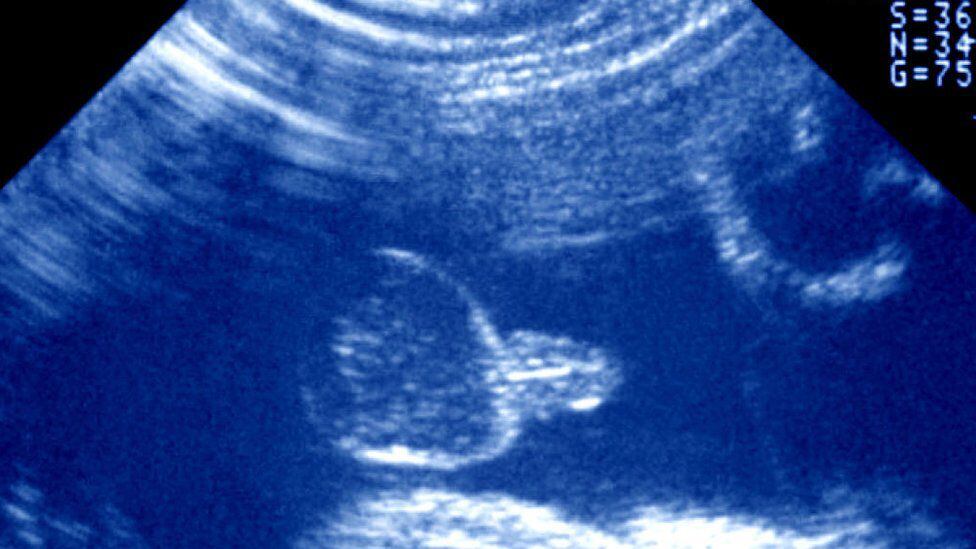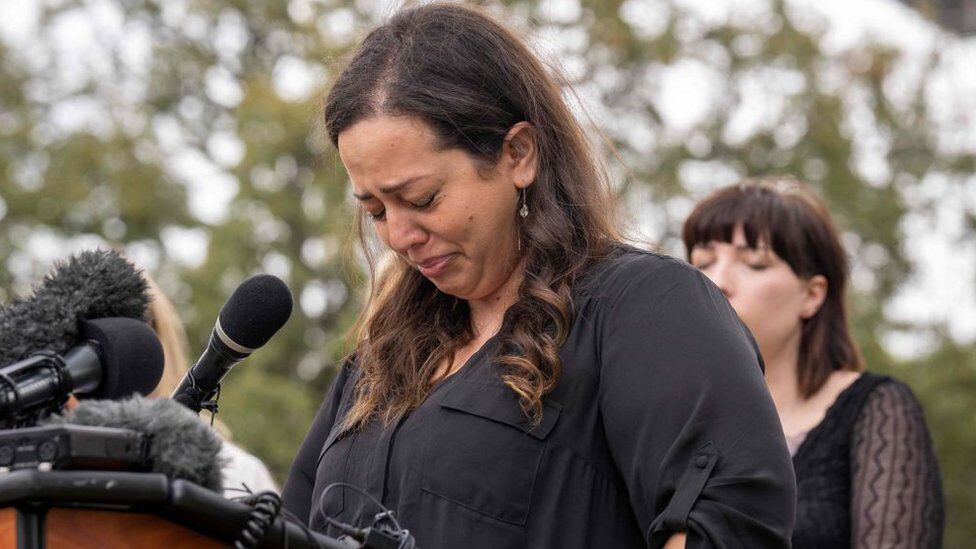Texas state law prohibiting all abortionsexcept in extreme medical circumstances, is one of the strictest introduced in the US since the right to the procedure was revoked in June of the previous year.
The most critical voices say that it is forcing many women and their doctors to choose between breaking the law or making the right decision for their health.
LOOK: Radio Row: the historic New York neighborhood that was razed to build the Twin Towers more than half a century ago
And this is where the story of Amanda Zurawski and her husband Josh begins. Both had recently purchased the house of your dreams.
Located in one of the most sought after areas of Austin, Texas, it had panoramic views of a lake and golf course.
Was the perfect place to welcome her first child, who was on the way.
But the day of the move – last August – was not at all what they had imagined.
Amanda had just left the hospital because her health had been complicated and her life was in danger after doctors denied her an abortion.
“I felt like I was living in a dystopian world,” Amanda told the BBC.
“No pregnant person in the United States should fear for their life because of the laws.”
In the twelve months since the Supreme Court struck down the Roe v. Wade ruling, giving states the right to ban abortion, 13 states have passed near-total bans.
Texas is the largest state to pass these laws, maybe one of the toughest.
Those laws prohibit all abortions from the moment of conception, except in cases of a “life-threatening physical condition” or “a serious risk of substantial impairment of a major bodily function.”
Breaking the law can lead to a fine of US$100,000 and a prison sentence of life imprisonment.
“Highly Desired”
When Amanda found out she was having a daughter, she and her husband were overjoyed.
But the same day she compiled the guest list for her baby shower, she was diagnosed with a problem that led her not only to lose her babybut also put her in the crosshairs of the Texas abortion ban.
The doctors told him that had cervical insufficiencywhich is a weakening of the cervical tissue that causes premature dilation, and they confirmed that their daughter would not survive at birth.
Amanda and her husband were devastated.
“Was a much wanted baby“, said.

The standard medical procedure for a nonviable pregnancy at that stage of development is end it and remove the fetus.
Waiting to miscarry naturally can put the mother at risk of infectionwhich can be fatal.
But the doctors told her that they could not terminate her pregnancy, since according to the laws of the state, it was a crime to perform an abortion when the fetal heart was beatingunless the mother’s life was in danger.
Essentially, the message was that she was not yet sick enough to legally justify an abortion.
Three days later, Amanda developed a life-threatening infection and he went into septic shock.

“My teeth were chattering uncontrollably, I couldn’t put a sentence together,” she said.
“Imagine when you have the worst flu you’ve ever had in your entire life and multiply that by a thousand. It was horrible.”
In the hospital, Ilabor was induced and the baby was finally miscarriedwhom he named Willow.
Then she was immediately sent to the intensive care unitwhere he spent the next few days.
The sepsis had scarred her uterus and fallopian tubes, causing her to one of the tubes will be permanently blocked.
Amanda is now one of 13 women and two doctors who have decided to sue the state of Texas in hopes of changing the ban, to give doctors more leeway to determine when an abortion is necessary.
The state has asked the judge to dismiss the case.

This Wednesday, Governor Greg Abbott signed legislation clarifying that doctors can use your “reasonable medical judgement” to prevent serious complications caused by ectopic pregnancies or premature rupture of membranes, which was the cause of Amanda’s sepsis.
new legislation
Abortion advocates and politicians who support the ban say Texas laws have always been clearly written, but the new legislation will help make it more explicit.
“If a doctor can foresee that a woman will develop potentially life-threatening sepsis, they can act immediately,” said Rebecca Parma, who directs abortion research and advocacy for Texas Right to Life.
He also noted that now that abortion has been banned, his group intends to advocate for increased social services for women and the extension of Medicaid, o Free health insurance, up to one year after delivery, to ensure that women’s health is not neglected.
But the Center for Reproductive Rights, which is funding the lawsuit on behalf of the women and doctors, said there wasn’t a list long enough to cover tAll cases in which an abortion may be medically necessary.
His position mirrors that of the American College of Obstetricians and Gynecologists, which says that each patient brings unique medical considerations to the table.
Dr. Leah Tatum, a member of the organization, who treats patients at the Austin Regional Clinic, says the Texas laws are so vaguely worded that they cause stress and anxiety to medical providers across the state, who fear being charged with a crime.
“I’m coming at this from an objective medical point of view,” he said. “A pregnancy has more risk for the patient than an early termination.”
“At what point in the law are you considering the patient’s life at risk?”

Medicine is not a black and white issue, he said, and cases that fall on gray ground are more difficult to interpret within the law.
Although she is part of a large clinic and has lawyers available to advise her, she is concerned about providers who do not have the same support system, particularly in rural areas.
“This is very different from how we were trained and what is the national standard for maternal care,” said Dr. Judy Levison, a physician who resides in Houston.
But he decided to stop seeing patients, partly because of these bans, and now it’s one of the two doctors who sues to the state.
Unethical
Levison primarily cared for low-income patients and felt that he had to start practicing medicine in an unethical way.
“Where were they going to get an abortion? How were they going to allow themselves to travel, get someone to take care of their children, be two days off work and maybe risk their job? Suddenly I felt that My hands were tied behind my back.”said.
And while the law, and recent legislation clarifying the law, makes exceptions when the mother’s life is in danger, Texas does not allow abortions in the case of lethal fetal abnormalitieswhich are medical problems that make the fetus unlikely to survive after birth.
Taylor Edwards, who is also a party to the lawsuit, said that because there were no exceptions to this, it was seen forced to leave Texas to undergo an abortion that terminated her non-viable fetus.

emotional torture
“The emotional torture of those two weeks cannot be described. I don’t know how to explain to people how absolutely terrible it is to know that you are pregnant with a baby that will not live“, said.
She is not the only one who has made the decision to leave the state to have an abortion.
Many have had to travel hundreds of miles to Kansas or New Mexico, sometimes calling a dozen or more centers to schedule your procedure, explains Kari White, M.D., of the Texas Policy Evaluation Project at the University of Austin.
“From an emotional point of view, Those people have had traumatic experiences. not because they were going to have an abortion, but because they weren’t sure if they could do it or not,” she told the BBC.
Like Amanda, Taylor also underwent fertility treatments, spent tens of thousands of dollars to conceive, only to discover in her second trimester that her daughter Phoebe would not survive.
At her 17-week scan last February, the doctor saw that the fetus had a condition known as an encephalocele. Taylor recalled the moment the doctor told her the baby would not survive: “I started screaming, I don’t know what came over me.”
She didn’t want to have to carry her daughter to term, only to give birth to a stillborn baby.
But the cost and stress of having to leave the state, too they affected him psychologically.
Three hours before her flight to New Mexico, the clinic said they had run out of medication needed for the procedure.
She eventually got a later appointment in the state of Colorado, just days before the 19-week limit was reached, after which the procedure could no longer be performed.

The total cost of the flights, hotel and abortion reached $6,000 and was not covered by insurance, he said.
“You shouldn’t have to deal with that when you’re going through the worst experience of your life,” he said.
“And on top of that seeing you in a situation where they make you feel like a criminal.”
As for Amanda, after losing Willow and moving back to her home in Austin, she and her husband discovered that a tree growing in the yard of their new home was a desert willow.
Every morning they greet him, feeling that their daughter is nearby.
Like the Edwardses, they began another round of fertility treatment in hopes of having another child.
As the first anniversary of the repeal of Roe v. Wade, both women say they are hopeful, but they are still going to fight.
“When I look back on the last year and everything that’s happened to me personally, but also on our political landscape, I see a lot of people mobilizing,” Zurawski said.
“I’ve said before that I don’t think there’s anything more powerful than an angry mom and right now there are a lot of angry moms.”
Source: Elcomercio
I am Jack Morton and I work in 24 News Recorder. I mostly cover world news and I have also authored 24 news recorder. I find this work highly interesting and it allows me to keep up with current events happening around the world.

:quality(75)/cloudfront-us-east-1.images.arcpublishing.com/elcomercio/DBVVCWAGYNEXZJYVZQDAXOYKHU.jpg)





